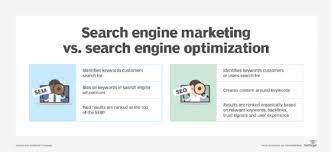
Unlocking the Potential of Paid Search Engine Optimization: A Guide to Maximising Your Online Visibility
The Power of Paid Search Engine Optimization
In the competitive landscape of online marketing, businesses are constantly seeking ways to enhance their visibility and reach their target audience effectively. One powerful strategy that has gained prominence in recent years is paid search engine optimization (SEO).
Unlike traditional SEO techniques that focus on organic search results, paid SEO involves investing in paid advertising to improve a website’s visibility on search engine results pages (SERPs). This approach allows businesses to bid on keywords relevant to their products or services and have their ads displayed prominently when users search for those terms.
Benefits of Paid SEO:
- Immediate Results: One of the key advantages of paid SEO is its ability to deliver immediate results. Unlike organic SEO, which can take time to yield noticeable improvements in rankings, paid SEO campaigns can generate instant traffic and leads.
- Precise Targeting: Paid SEO allows businesses to target specific demographics, locations, and interests with precision. This level of targeting ensures that ads are shown to users who are most likely to be interested in the products or services being offered.
- Enhanced Visibility: By investing in paid SEO, businesses can secure prime ad placements at the top of SERPs, increasing visibility and driving more traffic to their websites. This increased visibility can result in higher click-through rates and conversions.
- Detailed Analytics: Paid SEO platforms offer robust analytics tools that provide valuable insights into campaign performance. Businesses can track key metrics such as click-through rates, conversion rates, and ROI, allowing them to make data-driven decisions and optimise their campaigns for better results.
Key Strategies for Success:
To maximise the effectiveness of paid SEO campaigns, businesses should focus on the following key strategies:
- Keyword Research: Conduct thorough keyword research to identify relevant keywords with high search volumes and low competition.
- Compelling Ad Copy: Create engaging ad copy that entices users to click on your ads and visit your website.
- Landing Page Optimisation: Ensure that your landing pages are optimised for conversions and provide a seamless user experience.
- A/B Testing: Experiment with different ad creatives, targeting options, and bidding strategies to identify what works best for your business.
- Continuous Monitoring and Optimisation: Regularly monitor campaign performance and make adjustments as needed to improve ROI and achieve your marketing goals.
In conclusion, paid search engine optimization offers businesses a powerful tool for enhancing their online visibility, driving targeted traffic, and achieving measurable results. By implementing effective strategies and leveraging advanced analytics tools, businesses can harness the full potential of paid SEO to stay ahead in today’s competitive digital landscape.
Understanding Paid Search Engine Optimisation: Key FAQs for Businesses
- What is paid search engine optimization (SEO)?
- How does paid SEO differ from organic SEO?
- What are the benefits of investing in paid SEO?
- How can businesses target the right audience with paid SEO?
- What key metrics should businesses track in their paid SEO campaigns?
- What are some common strategies for maximising the effectiveness of paid SEO?
- Is paid SEO suitable for all types of businesses, regardless of size?
- How can businesses measure the ROI of their paid SEO efforts?
What is paid search engine optimization (SEO)?
Paid search engine optimization (SEO) is a dynamic digital marketing strategy that involves investing in paid advertising to improve a website’s visibility on search engine results pages (SERPs). Unlike traditional SEO methods that focus on organic rankings, paid SEO allows businesses to bid on relevant keywords and have their ads displayed prominently to users searching for those terms. By paying for ad placements, businesses can target specific audiences, drive immediate traffic to their websites, and enhance their online presence effectively. Paid SEO offers businesses the opportunity to reach their target customers efficiently and achieve tangible results through strategic keyword targeting and optimised ad campaigns.
How does paid SEO differ from organic SEO?
Paid search engine optimization (SEO) differs from organic SEO in its approach to improving a website’s visibility on search engine results pages (SERPs). While organic SEO focuses on optimising a website’s content and structure to rank higher in unpaid search results, paid SEO involves investing in paid advertising to achieve prominent placement on SERPs. With paid SEO, businesses bid on specific keywords relevant to their products or services and have their ads displayed when users search for those terms. This approach allows for immediate visibility and targeted reach, complementing the long-term benefits of organic SEO efforts. By combining both strategies effectively, businesses can maximise their online presence and drive quality traffic to their websites.
What are the benefits of investing in paid SEO?
Investing in paid search engine optimization (SEO) offers a multitude of benefits for businesses looking to enhance their online presence and reach their target audience effectively. One key advantage is the ability to achieve immediate results, as paid SEO campaigns can generate instant traffic and leads, unlike organic SEO which may take time to show noticeable improvements. Additionally, paid SEO allows for precise targeting, enabling businesses to tailor their ads to specific demographics, locations, and interests. This targeted approach increases the likelihood of engaging with users who are genuinely interested in the products or services being promoted. Furthermore, by securing prime ad placements at the top of search engine results pages (SERPs), businesses can significantly boost their visibility and drive more traffic to their websites, ultimately leading to higher click-through rates and conversions.
How can businesses target the right audience with paid SEO?
To target the right audience effectively with paid search engine optimisation (SEO), businesses can employ strategic tactics to ensure their ads reach the most relevant users. Firstly, conducting thorough keyword research is essential to identify the specific terms and phrases that potential customers are likely to use when searching for products or services. By selecting relevant keywords and incorporating them into ad campaigns, businesses can increase the likelihood of reaching users who are actively seeking what they offer. Additionally, utilising advanced targeting options provided by paid SEO platforms, such as demographic targeting, location targeting, and interest-based targeting, enables businesses to hone in on their desired audience segments with precision. By combining insightful keyword selection with targeted ad placements, businesses can maximise their chances of connecting with the right audience and driving valuable engagement and conversions.
What key metrics should businesses track in their paid SEO campaigns?
When it comes to paid search engine optimization campaigns, businesses should pay close attention to a range of key metrics to gauge the effectiveness of their efforts. Some crucial metrics to track include click-through rate (CTR), conversion rate, cost per click (CPC), return on investment (ROI), and quality score. Monitoring these metrics provides valuable insights into the performance of paid SEO campaigns, allowing businesses to optimise their strategies, allocate budgets efficiently, and ultimately achieve their marketing objectives with precision.
What are some common strategies for maximising the effectiveness of paid SEO?
When it comes to maximising the effectiveness of paid search engine optimisation (SEO), businesses can implement several key strategies to enhance their campaigns. Conducting comprehensive keyword research to identify high-impact keywords, creating compelling ad copy that resonates with the target audience, optimising landing pages for conversions, and continuously testing and refining campaign elements through A/B testing are common tactics used to boost the performance of paid SEO efforts. By monitoring campaign metrics closely, making data-driven decisions, and adapting strategies based on insights gained from analytics, businesses can ensure that their paid SEO initiatives deliver optimal results in terms of visibility, traffic, and conversions.
Is paid SEO suitable for all types of businesses, regardless of size?
When considering the question of whether paid SEO is suitable for all types of businesses, regardless of size, it’s important to recognise that the effectiveness of paid search engine optimisation can vary depending on various factors. While paid SEO can offer immediate results and targeted visibility, smaller businesses with limited budgets may find it challenging to compete with larger enterprises in highly competitive markets. However, with careful planning, strategic keyword selection, and a focus on niche targeting, businesses of all sizes can leverage paid SEO to enhance their online presence and reach their target audience effectively. Ultimately, the key lies in understanding your business goals, budget constraints, and target market to determine the most appropriate approach to maximise the benefits of paid SEO.
How can businesses measure the ROI of their paid SEO efforts?
Measuring the return on investment (ROI) of paid search engine optimization (SEO) efforts is crucial for businesses to evaluate the effectiveness of their campaigns and make informed decisions. To determine the ROI of paid SEO, businesses can track key performance indicators such as click-through rates, conversion rates, cost per acquisition, and revenue generated from paid search traffic. Utilising advanced analytics tools and setting up conversion tracking mechanisms can provide valuable insights into the impact of paid SEO on business objectives. By analysing these metrics and comparing them against the costs incurred for running paid SEO campaigns, businesses can accurately assess the ROI of their efforts and refine their strategies for optimal results.

